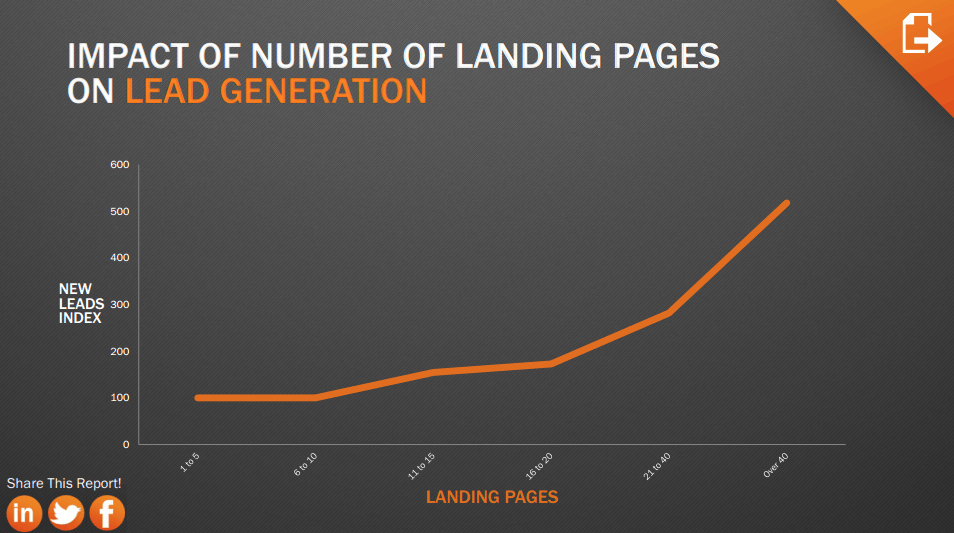You have just seconds to convince someone that your web page is worth reading.
Pages often contain too many distractions, and if the goal of your page is to have a visitor perform a specific action (e.g. download a white paper, contact you, sign up for a webinar, etc.) then the path to the goal must be crystal clear.
Landing pages are targeted pages created in mind to achieve a specific goal and for a specific channel (e.g. PPC, social media, email, etc.) Instead of directing a prospect to your homepage or contact page, steer them in the direction of a landing page.
In a recent study by HubSpot, they measured how the number of landing pages impacted lead generation:

As this graph shows, it’s important to increase the number of landing pages in order to improve your flow of leads. It sounds obvious, but often times it’s underutilized. In fact, according to the report, “companies see a 55% increase in leads from increasing landing pages from 10 to 15.”
Although landing pages are often used in SEM and email campaigns, most webmasters allow them to be indexed by search engines. In some cases it may be wise to exlude them from appearing in the search engines, but they offer an excellent opportunity to not capture leads organically. It also adds a whole lot of SEO value by providing optimized and relevant content on your website that can help you in the SERPS.
How to Increase the Number of Landing Pages on Your Website
1) Become more granular with your landing pages
Providing specific landing pages that really presents content that prospects are looking for. For example, if someone searches for, “Tennis equipment,” then create a separate landing page that presents tennis equipment, rather than sports equipment. If someone searches for, “tennis rackets,” then only show tennis rackets rather than general tennis equipment.
By making more relevant landing pages, I guarantee that conversion rates will increase.
2) Become more granular with your campaign setup
Structure your campaigns in a way where you segment by interest, keywords and/or questions. According to MarketingSherpa, segmenting email marketing campaigns can increase clicks up to 50%.
As a best practice for search marketing campaigns, it’s important to be granular with both your campaigns and ad groups. By structuring it in this manner, you’re able to target specific keywords with relevant ad copy. For example, if I search for “channel marketing software,” then I want to see an ad that closely relates to that search term – rather than just “marketing software.” This results in a better CTR, a better quality score, higher conversion rates and pre-qualified leads.
3) Generate more content for your audience
This will involve new campaigns that allow you to capture more leads by offering a variety of assets (for example) for various channels. Perhaps you are promoting webinars via your email marketing campaign, offering a free white paper via SEM or free industry specific tools via your social media.
More and more companies are now employing teams dedicated to creating valuable content that attracts prospects and turns them into leads. If you’re unable to afford those kind of resources then consider finding someone internally who’s looking for the responsibility and who has experience in content creation. It’s important for them to consult with subject matter experts (SMEs) on content before posting it.
An excellent and easy way to offer content to prospects is to repurpose content. For example, powerpoint presentations, interviews, webinars, a blog post on the top posts of the year, or updating content that you’ve previously produced.
What other ideas do you have to share? Are you struggling to come up with new content? Let us know in the comments section below:
Alex Pethick
Brit living in Raleigh, NC. Football (soccer) & boxing fan. Health nut. Oh, and I manage Zift's digital marketing presence.




